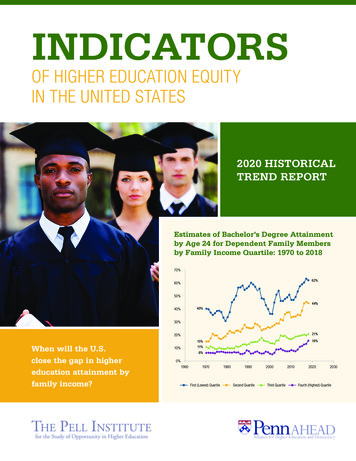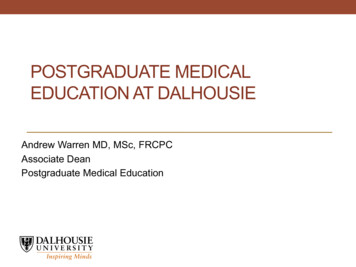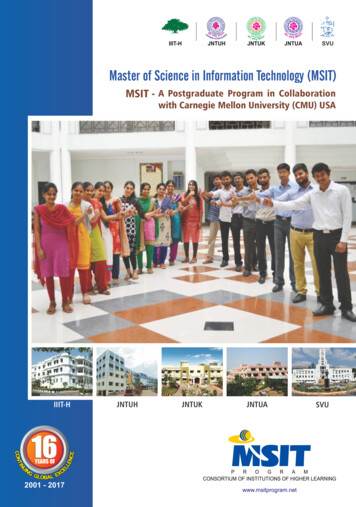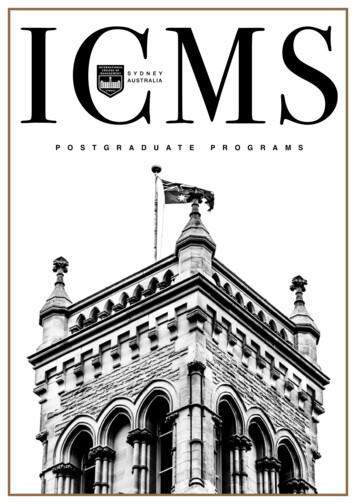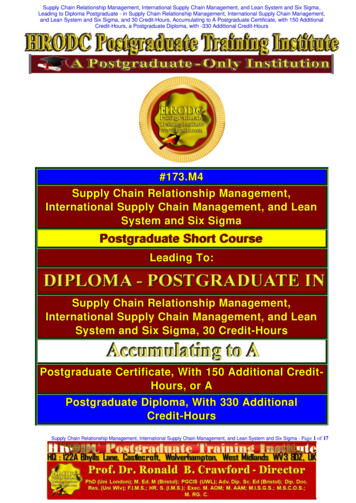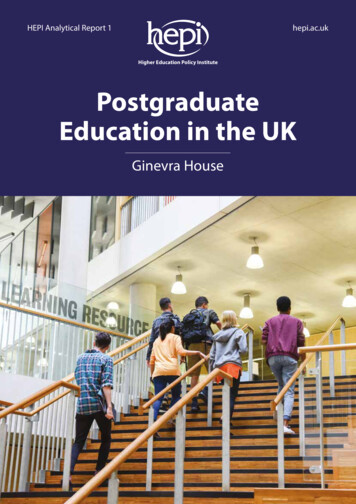
Transcription
HEPI Analytical Report 1hepi.ac.ukHigher Education Policy InstitutePostgraduateEducation in the UKGinevra House
About the authorDr Ginevra House is an independent researcher specialising, among other areas, in theUK and international higher education sector. She has conducted research projects andimpact evaluations for Universities UK International, the Association of CommonwealthUniversities and the British Library. Her other field of research is ethnomusicology,with a focus on Javanese gamelan, Japanese classical music and festivals and musicalcommunities and subcultures within the UK.Key points The introduction of postgraduate loans for study at Master’s level has led to a markedincrease in UK-domiciled student numbers, following several years of decline orstagnation. It also appears to have boosted participation among those from lessadvantaged backgrounds. Average Master’s fees for UK / EU students have inched closer to the maximum valueof postgraduate loans in England and, in some instances, have overtaken themleaving little or nothing for students’ living costs. EU-domiciled student numbers started to decline following the UK’s decision toleave the European Union (EU) in 2016, with the decline particularly pronouncedamong postgraduate researchers. Strong growth in non-EU postgraduate numbers has mainly been driven by Chinesestudents, who in 2017/18 formed 38% of the non-EU cohort; participation from othernon-EU countries declined by 10% from 2014/15. The imbalance of female to male postgraduates continues to grow, standing at 60:40overall, and 62:38 for UK-domiciled students. While uptake of postgraduate courses has increased overall, there has been amarked decline in numbers of older part-time students accessing lifelong learningopportunities. Participation is particularly low among the White British population and males fromlow-participation (disadvantaged) neighbourhoods, and there is particularly highparticipation within the Black African British demographic. There are now more students studying for UK postgraduate qualifications whollyabroad, via transnational education (TNE), than there are non-UK students in the UK.
ContentsExecutive summary 2Introduction 10Chapter 1What is postgraduate education? 13Chapter 2Who studies for postgraduate qualifications? 22Chapter 3Key trends in postgraduate study 63Chapter 4Institutional differences and regional disparities 90Chapter 5Costs and benefits 106Chapter 6Future demand 128Conclusion 138Appendix 1Level of study mapping 140Appendix 2Institutional groupings 143Appendix 3Appendix H (‘low risk’) countries 146Bibliography 147hepi.ac.uk1
Executive summaryThis report explores how the state of postgraduate education in the UK has changedover the past decade. It builds on two earlier HEPI reports published in 2004 and 2010,and mainly focuses on the period from 2008/09 to 2017/18.Overall, the number of postgraduate starters increased by 16% between 2008/09 and2017/18, with growth particularly marked among the ‘non-EU’ cohort ( 33%).Compared to the previous two publications, which mainly showed a steady increasein participation across most domiciles and demographics, the period covered in thisreport has been characterised by a high degree of turmoil in postgraduate numbers.UK, ‘other EU’ and ‘non-EU’ student numbers have all been affected, both positively andnegatively, by numerous domestic and international factors. These include: the 2008 financial crisis;changes to student funding;changes to study and post-study work visa policies;changes to Initial Teacher Training (ITT) and funding for post-qualificationstudy for teachers;the UK’s vote to leave the EU; andfluctuations in the value of the pound.The story over the last two years of data is mainly positive. The introduction of Master’sloans led to strong growth among UK students.With Government strategies now in place to boost international student numbers andimprove the early-career package for new school teachers, as well as a populationbulge in the age group due to reach the typical age for starting postgraduate studyafter 2023, the next decade could see further growth.2Postgraduate Education in the UK
However, the Covid-19 crisis, which was unfolding at the time this report went to print,is likely to have a profound impact on higher education. While it is too early to makepredictions, the events of the last decade – especially the 2008 financial crash – mayhelp us to understand the connections between postgraduate study and externalfactors. For example, the report shows where the sector has become the most relianton international students, whose numbers may fall, at least in the short-term. At thesame time, the steady expansion of transnational education means there is moreinfrastructure for studying UK qualifications abroad.In times of upheaval, societies need a resilient, highly-skilled and flexible workforce. Therole of postgraduate education in developing these attributes will be more importantthan ever in the years to come.By providing a detailed picture of the state of postgraduate education in the UK in thetime before the pandemic hit, it is hoped this report provides a benchmark againstwhich its impact can be measured.Key findingsA) Who studies for postgraduate qualifications?The cohort There were 566,555 postgraduate students in 2017/18, of which 356,996 werefirst-year starters. The proportion of UK citizens under 30 expected to participate in postgraduateeducation has risen to 11%, having increased from 9% following the introduction ofMaster’s loans in 2016.Level of study Almost two-thirds of postgraduate starters (65%) are studying for Master’s degrees. Doctoral and other research postgraduates account for 10% of the cohort. 7% are on Initial Teacher Training (ITT) courses. The remaining 18% are studying for ‘other postgraduate’ qualifications, includingdiplomas, certificates, professional qualifications and individual modules for creditsthat can count towards larger qualifications.hepi.ac.uk3
Subject Business & Administrative Studies is the most popular subject (20%), followed byEducation (14%) and Subjects Allied to Medicine (12%). Almost two-thirds of research postgraduates (64%) study STEM (Science,Technology, Engineering and Mathematics) subjects; the opposite is true for taughtpostgraduates, where 68% study non-STEM subjects. STEM study increased from 31% to 37% of the postgraduate cohort from 2008/09 to2017/18 – and from 29% to 42% among UK-domiciled students. While most subjects are seeing more students, there has been a 36% decline inEducation at all levels of study.Mode of study Just over half (53%) of UK-domiciled postgraduate starters study full-time,representing a major shift over the study period: in 2008/09, 59% were part-time. Postgraduate loans for Master’s degrees have had a marked impact by making iteasier to study full-time, but the decline in part-time began long before they wereintroduced. Rising fees and gaps in student finance provision for shorter courses areamong the likely deterrents affecting older part-time students.Domicile 60% of the cohort is from the UK, 8% from elsewhere in the EU and 32% fromnon-EU countries. International students are particularly important in the Master’s sector, where themajority (53%) are from outside the UK. Non-EU students, however, only outnumber UK-domiciled students in two subjectareas: Business & Administrative Studies and Engineering & Technology.Sex In 2017/18, the female-to-male ratio among first-year postgraduates was 60:40;among UK-domiciled students, it was 62:38. Females outnumber males in every course type except doctorates, where males holda slim majority at 51%. The skew in UK-domiciled students is, in part, driven by very high female participationin ITT (70%) and Subjects Allied to Medicine (77%) reflecting the greater proportionof women pursuing teaching and nursing careers. Female participation is also highin Biological Sciences (69%). However, over the whole cohort, males remain in a clear majority in Mathematics,Computer Science, Engineering & Technology, and Architecture, Building & Planning.4Postgraduate Education in the UK
Over the study period, female participation has increased overall, while maleparticipation has mainly flatlined. Male underachievement at school level is amongthe likely drivers of the latter, since males and females with equal GCSE qualificationsprogress to higher education at similar rates.At the same time, the substantial wage gap between men and women with thesame qualifications may also be driving rising female participation, creating strongerincentives for women to invest in higher levels of education.Age Participation by those aged over 30 has decreased from 48% to 43% over thestudy period. This is in keeping with the decline in part-time students, who are overwhelminglyolder, and marks a general decline in those accessing lifelong learning opportunities.Ethnicity Participation by UK-domiciled BAME (Black, Asian and Minority Ethnic) studentsis strong: 22% of UK postgraduates identified as coming from an ethnic minority,compared to 20% of the general population aged 20-to-34 years (the typical age forpostgraduate study). White British students are under-represented at postgraduate level, representing75% of the cohort but 80% of the general population. Black British African students are particularly strongly represented, forming 5% ofthe postgraduate cohort, but only 1% of the general population aged 20-to-34.Educational (dis)advantage Master’s loans have markedly improved participation among students fromdisadvantaged backgrounds: students from non-professional backgrounds nowform 49% of the cohort, up from 35% in 2008/09. Following the introduction of these loans, the number of young entrants to eligiblecourses rose by 59% in POLAR quintile 1 neighbourhoods (areas with the lowestlevels of participation in higher education). Under-participation by males is particularly pronounced in low participationPOLAR quintiles.hepi.ac.uk5
Transnational education (TNE) 139 of 168 UK higher education providers are involved in providing UK qualificationsto students studying wholly outside the UK. In 2017/18, there were more international postgraduates studying in this way(127,825) than there were EU and non-EU students in the UK (111,920). Transnational education student numbers have more than doubled since 2007/08,having increased by 108%.B) Key trends in postgraduate studyStarts There was a 16% increase in postgraduate starters over the study period.Level of study Doctoral, Master’s by research and other research postgraduate numbers haveincreased by 17% over the study period, although they have been fairly static since2013/14. The introduction of doctoral study loans in 2018/19 may have nudged UK-domiciledpostgraduate research numbers up a little, but not to the dramatic increases seenwith Master’s loans. Taught Master’s student numbers increased by 30% over the study period, but notconsistently – there has been high volatility driven by a complex array of factorsaffecting both domestic and international students. In ITT, recruitment has been consistently below target since 2012/13, withunder-recruitment in many key subjects at the same time as a population bulge hitsecondary schools. Other types of taught postgraduate study, such as professional qualifications,certificates and diplomas – all of which are predominantly studied by older, part-timestudents – declined by 10% over the study period.Domicile UK-domiciled postgraduate numbers have increased overall by 10% since 2008/09,but have been volatile over the research period. The 2008 financial crash appears to have boosted UK-domiciled postgraduatenumbers in its immediate wake, while job opportunities were poor, but led to adecline in subsequent years, due to people having brought their study plans forward. Student loans brought about another surge in numbers: UK-domiciled Master’sstudents increased by 29% in 2016/17.6Postgraduate Education in the UK
Although EU student numbers have risen by 11% over the research period, they havebeen fairly static since 2012/13.EU postgraduate numbers have been declining since the UK voted to leave the EU,dropping by 2% in 2017/18 and a further 2% in 2018/19.The decline is particularly marked among postgraduate researchers, with 9% fewerEU-domiciled starters in 2018/19 than the previous year.Non-EU student numbers have grown by 33% since 2008/09.There have been more non-EU than UK-domiciled full-time equivalent Master’sstudents throughout the research period.The growth in non-EU postgraduates is mainly due to a sustained increase inpostgraduates from China (up by 21% since 2014/15), which has counteractedsubstantial reductions from other non-EU countries (down by 10% since 2014/15).In 2017/18, Chinese students formed 38% of the non-EU postgraduate cohort (allyears). Heavy reliance on students from a single country exposes universities togreater risk.The decreased diversity of the UK’s international postgraduate cohort wasaccentuated by the abolition of post-study work visas, which negatively affectedinterest from certain countries, such as India. However, the 2019 decision toreintroduce them could reverse this trend in coming years.The crash in the pound following the EU referendum made UK fees cheaper forinternational students, probably contributing to the 10% rise in non-EU postgraduatenumbers in 2017/18.C) Institutional differences and regional disparitiesInstitutional differences Russell Group institutions host 59% of all postgraduate researchers. The top ten institutions with the most taught postgraduate students are increasinglydominated by elite pre-1992 universities, reversing a trend towards greater diversityseen in the previous HEPI Postgraduate Education report in 2010. Many specialist arts colleges host a substantial proportion of EU students, andtherefore face a greater risk if Brexit acts as a deterrent to EU students.Regional disparities Of the devolved administrations, Scotland retains the most locally-domiciledpostgraduate students (87% study at Scottish providers), followed by NorthernIreland (75%) and Wales (67%). Retention of postgraduate qualifiers has increased for Wales over the study period,but decreased for Scotland and Northern Ireland.hepi.ac.uk7
D) Costs and benefitsCost to students Master’s fees for UK-domiciled students rose sharply – by 10% – when postgraduateloans were introduced. In 2019/20, average fees for classroom-based courses wereclose to 8,000 and nearing 9,000 for laboratory-based subjects. With the maximum loan available to England-domiciled students set at 10,906(2019/20), fees now threaten to consume the entirety of the loan, leaving little ornothing to live on. Although non-EU Master’s fees have risen by a similar amount in pounds, they haveactually flatlined when considered in US dollars (or Chinese yuan), due to the fallingvalue of the pound. If home Master’s fees continue to rise unchecked, the benefits conferred bypostgraduate loans in terms of boosting UK student numbers – especially amonggroups targeted for widening participation – may not be sustained.Benefits of postgraduate education Postgraduates earn, on average, 18% more than those with only undergraduatequalifications. Women’s salaries trail behind those of men with the same qualifications and are 14%lower for females with postgraduate qualifications when compared to males withpostgraduate qualifications. Despite this, a postgraduate qualification confers greater advantages for womenthan men: female postgraduates earn, on average, 28% more than those with onlyundergraduate degrees; for males the advantage is only 12%. Postgraduates were more likely to be in employment than first-degree graduatesthroughout most of the study period, especially following the 2008 financialcrisis, where postgraduate employment levels were slower to fall and recoveredmore quickly. However, in 2018 this trend reversed: employment levels among postgraduatesaged 21-to-30 were 2% lower than first-degree graduates. Access to the professions is markedly stronger for postgraduates, having remainedat over 90% of working leavers throughout the research period. The postgraduate advantage in this regard may be diminishing slightly, however, withmore undergraduates now going straight into professional roles and graduate employersincreasingly looking beyond educational qualifications to diversify their workforce. In particular, it appears that starting a Master’s degree immediately aftergraduating from a first degree may be less advantageous than spending timeworking first (except in specialist subjects, such as Medicine, Law or Architecture,where postgraduate qualifications are a prerequisite).8Postgraduate Education in the UK
E) Future demandUK demand for postgraduate places There is currently a declining number of 18-to-24-year-olds passing through theuniversity system. However, this is set to change, with the number of students of thetypical age for starting postgraduate study set to increase after 2023. More people than ever are participating: 11% of the under-30 UK populationis expected to take a postgraduate degree – up from 9% before Master’s loanswere available. If undergraduate participation continues to rise at its current rate, hitting 54%in 2030, and if progression directly from undergraduate to postgraduate studyremains at 19% (the figure for 2016/17), then it would mean an additional 22,750undergraduate leavers going directly to postgraduate study. This does not includethose who start a year or more after graduating. If under-represented groups (males, certain ethnicities, those from low-participationneighbourhoods and older part-time students) continue to increase theirparticipation, this will mean greater demand again.EU demand Assuming first-degree EU students have to pay full international fees after the Brexittransition period, it has been predicted that numbers may decline by around 60%. This would translate to approximately 11,500 fewer EU postgraduates.International demand If the Government’s strategy to increase international student numbers is successful,the UK may see an additional 53,000 international postgraduate students by 2030. Meeting this target will rely on a number of factors influencing international studentnumbers, including: the relative strength of the pound; global macroeconomicfactors; the UK’s visa regime; international relations and diplomacy; and the longerterm implications of the Covid-19 pandemic on international student mobility.hepi.ac.uk9
IntroductionThe purpose of this study is to provide an overview of the postgraduate educationsector in the UK and to highlight areas that may be of interest to policymakers. Itprovides a continuation and extension of HEPI’s previous reports on postgraduateeducation in the UK published in 2004 and 2010.This report mostly looks at the sector from a UK-wide perspective, unless dealingspecifically with regional differences. However, since the large majority of the studentsin higher education are registered at English universities, this only gives us a clearpicture of what is happening in England and does not always necessarily reflect thesituation in Scotland, Wales and Northern Ireland, or indeed any one of the nine Englishregions. The reader should bear in mind that many of the discussions focus mainly onthe situation in England yet deal with issues, such as funding, which are not uniformthroughout the UK. As a result, the analysis may not always be applicable elsewhere.Most of the data used in this report come from the Higher Education Statistics Agency(HESA). Some of the figures are available in HESA’s published data on students in highereducation and their Destinations of Leavers from Higher Education (DLHE) survey.1 However,most analyses in this report rely on a special dataset commissioned from HESA with afiner breakdown of the various types of postgraduate qualification. This was necessarybecause HESA’s open data tables tend not to differentiate between specific postgraduatequalifications, just between research and taught postgraduate qualifications.The specially-commissioned dataset describes first-year postgraduate students from2008/09 to 2017/18, disaggregated according to the level of qualification beingundertaken, mode of study, domicile, sex, age, ethnicity, socio-economic background,whether students are from high- or low-participation neighbourhoods and sources offunding and tuition fees. Since the last report, however, the way various course aimshave been mapped to form broader ‘level of study’ groups has changed substantially110Available online at www.hesa.ac.uk and made available under the Creative Commons Attribution4.0 International (CC BY 4.0) licence.Postgraduate Education in the UK
for every category of postgraduate course other than doctorates and Master’s degrees,to reflect changes in the courses being offered by universities and the introductionof some new course designations by HESA. As such, findings that explore trends incertificates and diplomas, professional qualifications, teaching qualifications and ‘othertaught postgraduate’ study cannot be directly compared to those presented in HEPI’s2010 or 2004 Postgraduate Education reports.Due to delays caused by the remapping process, this report was only ready forpublication after the 2018/19 HESA student data became available. Reflecting this,some analyses (such as ethnicity) that do not rely on our bespoke dataset but draw onthe open data have been updated to reflect the most recent figures. Where feasible,2018/19 figures have been added to the text.The most recent Destinations of Leavers data used in this report are from 2016/17.Under the normal schedule, the 2017/18 data would have been available at the pointof writing, but HESA have been switching to the new Graduate Outcomes survey. Thisreport therefore offers a final analysis of DLHE data before this switch.The report draws on a number of other primary data sources and secondary sourceanalyses by other authors. The reader should bear in mind that similar datasets fromdifferent agencies (such as the Department for Education and HESA) may be gatheredin different ways and are not always comparable. Similarly, the methodologies used byauthors of secondary sources may differ from those applied in this report, so figuresmay not always be comparable across the board.Chapter 1 gives an overview of the various types of postgraduate qualification.Chapter 2 gives a snapshot of the postgraduate cohort in 2017/18, looking at what andhow people study, as well as the demographic features of the cohort.Chapter 3 focuses on key trends over time, showing the various types ofpostgraduate course and changes influencing students of different domiciles.Chapter 4 looks at institutional differences in terms of the numbers of postgraduatesthey attract, and also examines mobility of students and postgraduate qualifiers aroundthe country.Chapter 5 explains university funding structures and analyses the benefits ofpostgraduate education from the students’ and universities’ perspectives.hepi.ac.uk11
Finally, Chapter 6 looks at factors that may affect future demand for postgraduateeducation.Special thanks are due to Nick Hillman, Emma Ma and Rachel Hewitt of HEPI, John Caterof Edge Hill University and Paul Wakeling of the University of York for editorial,statistical and stylistic advice and help finding sources and to Helen Bell forproofreading and copy editing.Thanks are also due to the following people for their help and advice: Simon Baker(Times Higher Education); Charlie Ball (Prospects); Claire Callender (Birkbeck and UCLInstitute of Education); Josh Chaplin (Jisc / HESA); Zara Green (Centre for ProfessionalQualifications); Stephanie Harris and Daniel Wake (Universities UK International);Tristram Hooley (Institute of Student Employers); Joey Jones (YouthSight);Michelle Morgan (Michelle Morgan, HE Transitions Specialist, creator and authorof www.improvingthestudentexperience.com); Emily Raven (HESA); Gijsbert Stoet(University of Essex); and Heather Williams (Office for Students).12Postgraduate Education in the UK
Chapter 1What ispostgraduate education?This chapter provides an overview of the postgraduate sector, defines the terms usedto describe different types of postgraduate qualification and sets out how the varioustypes of postgraduate study have been grouped for this report.There is no single definition of the term ‘postgraduate’ although it is often used todescribe further study undertaken by those who already have an undergraduatedegree. It is frequently used to refer to Master’s or doctoral studies, but it also includescertificates and diplomas which are taught to a more academically demanding standardthan undergraduate certificates and diplomas.A distinction is sometimes made between courses which are postgraduate in level –which is to say that they are more advanced than undergraduate courses with similarsubject matter – and courses which are postgraduate only in the sense that they arestudied by people who already hold degrees (‘postgraduate in time’). This reportfocuses on postgraduate-level courses only.The Quality Assurance Agency (QAA), in its 2014 Framework for Higher EducationQualifications of UK Degree-Awarding Bodies, defines qualification types according toeight FHEQ (Framework for Higher Education Qualifications) levels. The first three aresecondary-level qualifications, the next three refer to higher education qualificationsup to Bachelor’s degrees, and the highest two correspond to postgraduate study.2Scotland has a parallel system, the Framework for Qualifications of Higher EducationInstitutions in Scotland (FQHEIS), which reflects the features of its different educationsystem while aligning it with the framework for England, Wales and Northern Ireland.2Quality Code for Higher Education, QAA.hepi.ac.uk13
At the postgraduate-level, the frameworks have common structures, qualification titlesand qualification descriptors. See Table 1.1 for a comparison of these two systems.Table 1.1 QAA Framework for Higher Education Qualifications (FHEQ), showingequivalency with the Framework for Qualification of Higher Education Institutionsin Scotland (FQHEIS)Typical higher education qualifications awarded by degree-awardingbodies within each levelDoctoral degrees (e.g. PhD / DPhil, EdD, DBA, DClinPsy)FHEQFQHEIS812711Master’s degrees (e.g. MPhil, MLitt, MRes, MA, MSc)Integrated Master’s degrees (e.g. MEng, MChem, MPhys, MPharm)Primary qualifications (or first degrees) in Medicine, Dentistry andVeterinary Science (e.g. MB ChB, MB BS, BM BSe; BDS; BVSc, BVMS)Postgraduate diplomasPostgraduate Certificate in Education(PGCE) / PostgraduateDiploma in Education (PGDE)Postgraduate certificatesBachelor’s degrees with honours (e.g. BA / BSc Hons)10Bachelor’s degreesProfessional Graduate Certificate in Education (PGCE)in England, Wales and Northern Ireland69Graduate diplomasGraduate certificatesFoundation degrees (e.g. FdA, FdSc)Diplomas of Higher Education (DipHE)N/A5Higher National Diplomas (HND) awarded by degree-awarding bodiesin England, Wales and Northern IrelandHigher National Certificates (HNC) awarded by degree-awarding bodiesin England, Wales and Northern IrelandCertificates of Higher Education (CertHE)Source: QAA, Framework for Higher Education Qualifications, p.1714Postgraduate Education in the UK8N/A47
The QAA definitions are based on the ‘achievement of outcomes and attainment,rather than years of study’.3 This means that Master’s degrees – which generally requireat least one full year of study – sit at the same level as shorter postgraduate courses,such as professional qualifications, which demand a comparable level of intellectualattainment but less time.As well as defining qualification levels, the QAA Framework provides guidance as toqualification nomenclature, promoting ‘a shared and common understanding ofthe demands and outcomes associated with typical qualifications by demanding aconsistent use of qualification titles across the higher education sector’.4These distinctions are important as they allow equivalency between postgraduateofferings that may be structured very differently. For example, the majority of taughtMaster’s courses outside the UK are two-year rather than one-year courses. TheFramework assures equivalency of outcomes and intellectual attainment despite thedifferent course lengths.The Higher Education Statistics Agency (HESA) cuts the cake slightly differently,defining four levels of postgraduate study: D for doctorates obtained primarily through research (FHEQ Level 8);L for research-based higher degrees which do not meet the criteria for a doctorate,such as Master’s by research degrees (Level 7);E for advanced level taught postgraduate study, including taught doctorates andhighly advanced diplomas (Level 8); andM for all other taught postgraduate qualifications, including Master’s degrees,teaching qualifications and other postgraduate certificates and diplomas (Level 7).5In most of HESA’s public datasets, postgraduate students are presented on two levels:research postgraduate (Levels D and L) and taught postgraduate (Levels E and M). Thisdiffers from the QAA’s approach, which treats all doctorates as equal, regardless ofwhether they are primarily research-based or taught, and groups taught and researchMaster’s degrees together despite the very different skills involved.3Framework for Higher Education Qualifications of UK Degree-Awarding Bodies, 2014, seaimhepi.ac.uk15
Terminology of postgraduate degreesDoctoral degreesA doctoral degree is awarded for the creation of new knowledge through originalresearch or oth
6 Postgraduate Education in the UK Transnational education (TNE) 139 of 168 UK higher education providers are involved in providing UK qualifications to students studying wholly outside the UK. In 2017/18, there were more international postgraduates studying in this way (127,825) than there were EU and non-EU students in the UK (111,920).


